Method for purification of silicon tetrachloride
- Summary
- Abstract
- Description
- Claims
- Application Information
AI Technical Summary
Benefits of technology
Problems solved by technology
Method used
Image
Examples
example 1
Catalyst Activation Treatment
[0039]Activated carbon (trade name: Spherical Shirasagi X7100H (dry), manufactured by Japan EnviroChemicals, Ltd.) was heated at 300° C. to remove moisture for 2 hours and then cooled down to room temperature. A packed tower 14 having an inner diameter of 30 mm and a length of 200 mm equipped with flat perforated plates was charged with 53 g of the activated carbon from which moisture was removed to form a catalyst layer 7.
[0040]Next, a four neck flask 4 equipped with a cooling tube 10, a thermometer 9, a silicon tetrachloride-dropping device 1 of 500 ml and the packed tower 14 equipped with flat perforated plates was heated at 120° C. on an oil bath 5, and the packed tower 14 was heated at 350° C. by a ribbon heater 8. A heat insulating material 15 was wound on the ribbon heater 8 to prevent heat from being released from the filling tower 14.
[0041]Then, silicon tetrachloride (hereinafter referred to as “silicon tetrachloride before refining treatment”) ...
example 2
[0044]The catalyst activation treatment in Example 1 was carried out, and then the contact treatment was carried out on the same conditions as in Example 1, except that the packed tower 14 was heated at 350° C. by the ribbon heater 8; 300 ml of the silicon tetrachloride before refining treatment was dropwise added from the silicon tetrachloride-dropping device 1 at a rate of 2 ml / minute under room temperature; and the dehumidified air A was supplied to the four neck flask 4 at a rate of 0.4 L / hour (23° C.)
[0045]Further, the silicon tetrachloride after the contact treatment was distilled at a distillation temperature of 5° C. by means of a distillation apparatus having a theoretical stage number of 10 stages which was not illustrated in order to separate by-produced carbon tetrachloride.
[0046]The silicon tetrachloride obtained by the distillation was analyzed by means of the gas chromatographic mass spectrometer (GC-MS) to find that a content of the carbon tetrachloride which was 11 ...
example 3
[0047]The contact treatment in Example 2 was carried out, and then the contact treatment was further carried out on the same conditions as in Example 2 by using 300 ml of the silicon tetrachloride before refining treatment. The silicon tetrachloride (not distilled) obtained after the contact treatment was analyzed by means of the gas chromatographic mass spectrometer (GC-MS) to find that the contents of the respective organic chlorosilanes which were impurities were less than 0.01 wppm (less than the detection lower limit). The results thereof after the contact treatment are shown in Table 1.
PUM
| Property | Measurement | Unit |
|---|---|---|
| Temperature | aaaaa | aaaaa |
| Fraction | aaaaa | aaaaa |
| Fraction | aaaaa | aaaaa |
Abstract
Description
Claims
Application Information
 Login to View More
Login to View More - R&D Engineer
- R&D Manager
- IP Professional
- Industry Leading Data Capabilities
- Powerful AI technology
- Patent DNA Extraction
Browse by: Latest US Patents, China's latest patents, Technical Efficacy Thesaurus, Application Domain, Technology Topic, Popular Technical Reports.
© 2024 PatSnap. All rights reserved.Legal|Privacy policy|Modern Slavery Act Transparency Statement|Sitemap|About US| Contact US: help@patsnap.com








